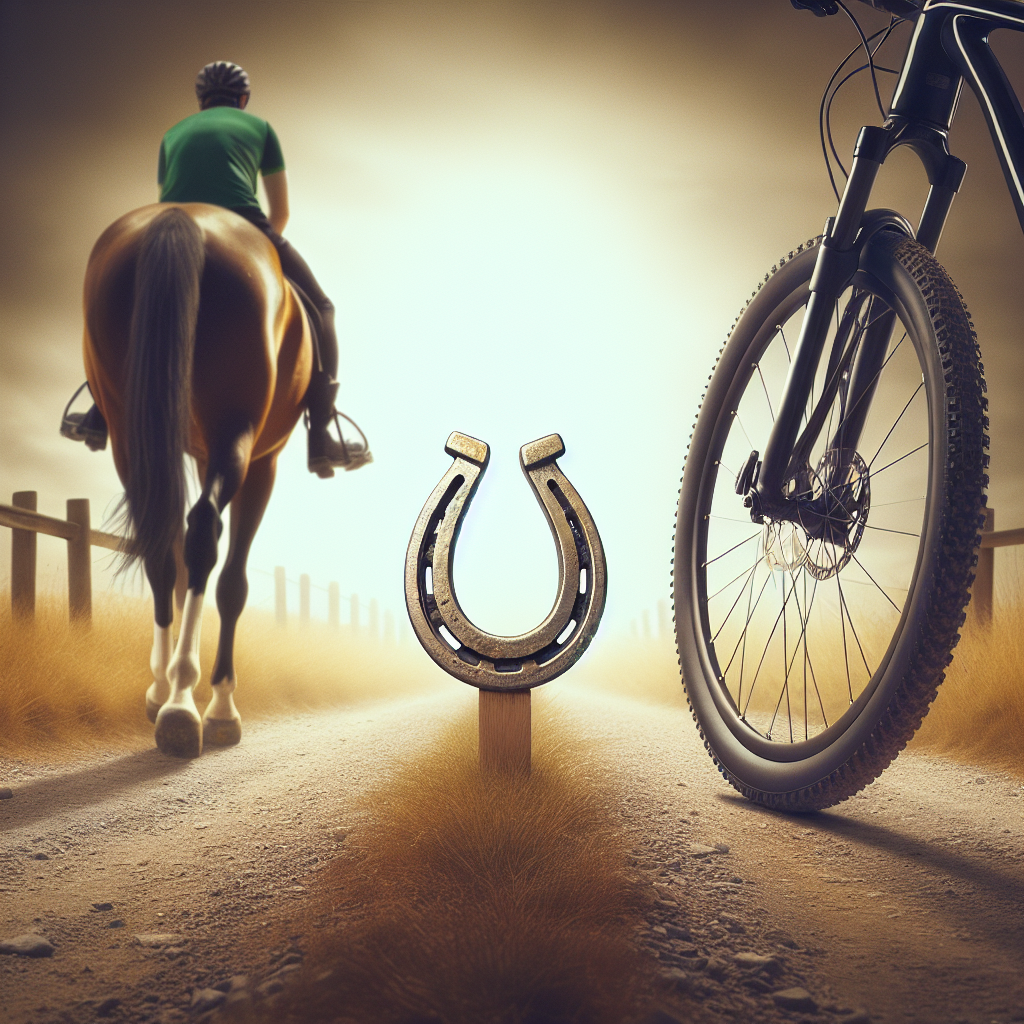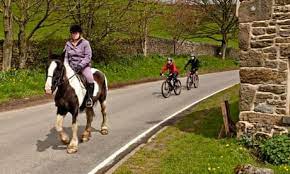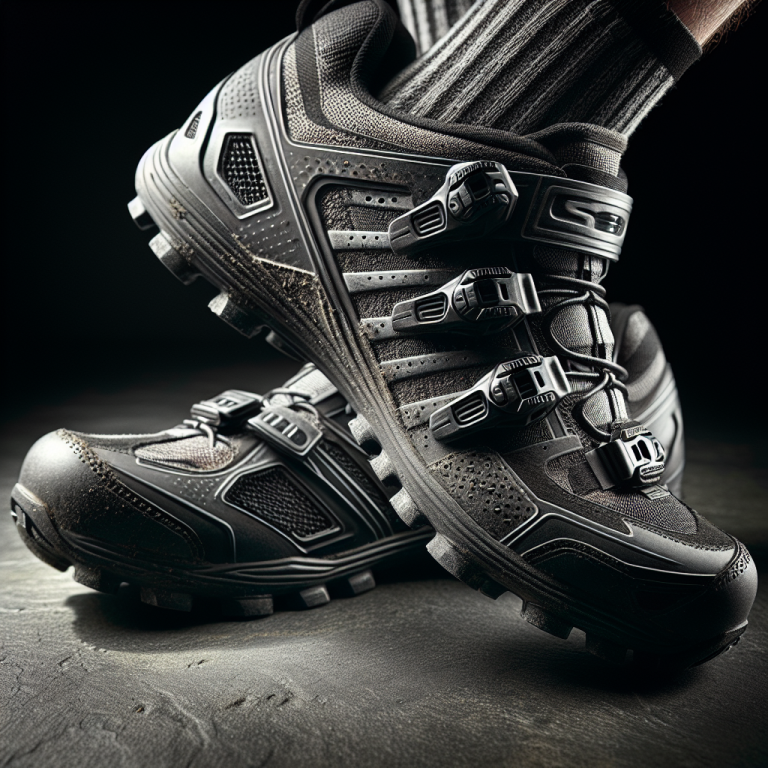Imagine this scenario: you’re out on a peaceful bike ride, enjoying the fresh air and picturesque views, when suddenly, you come across a horse rider on the same path. In this article, we will explore the importance of cycling etiquette when encountering a horse rider. From giving them ample space to passing safely, understanding these etiquettes will not only ensure a pleasant experience for both parties but also promote harmony on shared trails. So, hop on your bike and let’s discover the do’s and don’ts of sharing the road with our equine friends!
Table of Contents
ToggleUnderstanding Horse Behavior
Recognizing a horse’s flight response
When encountering a horse, it is crucial to understand their natural flight responses. Horses are prey animals, and their instinct is to flee when they sense danger. As a cyclist, it’s important to recognize the signs of a horse’s flight response, such as pricked ears, raised head, and tense body language. By being aware of these signals, you can adjust your behavior to avoid startling the horse and potentially putting yourself and the rider in danger.
Understanding a horse’s body language
To effectively communicate with a horse and ensure a safe encounter, it’s essential to understand their body language. Horses use their ears, eyes, and tail movements to convey their intentions and emotions. When approaching a horse, pay attention to their ear position, which can indicate whether they are focused, relaxed, or anxious. Additionally, a horse’s eye and body movements can provide valuable insight into their state of mind. Educating yourself on these cues will help you gauge the horse’s comfort level and adjust your actions accordingly.
Knowing the horse’s blind spots
Horses have a limited field of vision and certain blind spots that you need to be aware of when approaching them. Directly in front and behind the horse, as well as directly under their head, are areas where they have little to no vision. When approaching a horse, it’s important to avoid sudden movements within these blind spots, as this can startle or agitate them. By maintaining a safe distance and ensuring that you are visible to the horse, you can avoid surprising them and maintain a calm and respectful encounter.
Approaching a horse calmly and quietly
When approaching a horse, it is crucial to remain calm and approach them in a quiet manner. Sudden noises or loud voices can startle the horse and potentially lead to dangerous situations. Instead, speak softly and soothingly to the horse to let them know you are nearby. Approach slowly and give the horse ample space to assess your presence. By maintaining a calm and quiet demeanor, you can create a peaceful and non-threatening environment for both you and the horse.
General Etiquette
Yielding to the horse
When encountering a horse and rider, it is important to yield the right of way to ensure their safety. Slow down your cycling speed and be prepared to stop if necessary. As a respectful cyclist, you must understand that the horse is a larger and more vulnerable road user than you, so it is crucial to give them priority.
Reducing speed and avoiding sudden movements
To avoid startling the horse, reducing your cycling speed is essential. Approach the horse at a slow and steady pace, giving them time to assess your presence. Avoid sudden movements or gestures that could alarm the horse, such as reaching out or waving your arms. By maintaining a controlled and predictable movement, you create a sense of reassurance for the horse and rider.
Speaking softly to the horse and rider
When passing a horse and rider, it’s important to maintain a calm and friendly environment. Speak softly, using a soothing tone of voice to let the horse and rider know you are approaching. This gentle vocalization can help the horse familiarize themselves with your presence and reduce any anxiety or tension. Remember, a calm and relaxed atmosphere contributes to a positive encounter for everyone involved.
Keeping distance and avoiding tailgating
Maintaining a safe distance from the horse and rider is crucial to their safety and well-being. Avoid tailgating or following the horse too closely as this can create anxiety and discomfort for both the horse and the rider. Keep a distance of at least one horse’s length to ensure the horse has enough space and to minimize the chances of any mishaps. Respecting this distance demonstrates your consideration for their well-being.
Passing a Horse and Rider
Announcing your presence
When approaching a horse and rider from behind, it is essential to announce your presence to avoid surprising them. A simple verbal greeting such as “passing on your left” or “coming up behind you” can help the rider and horse become aware of your presence. By giving them a heads up, they can prepare themselves and make any necessary adjustments to ensure a smooth and safe passing.
Slowing down and waiting for permission
Before passing a horse and rider, it is important to slow down and wait for their permission to overtake. Horses can be easily startled, so it is crucial to allow the rider to assess the situation and give you the go-ahead. Patience is key during this process, as it may take some time for the rider to feel comfortable with your presence. By demonstrating patience and respect, you can ensure a peaceful and safe passing experience.
Giving the horse enough space
When passing a horse and rider, it is essential to give the horse sufficient space to feel comfortable and secure. Maintain a safe and respectful distance to avoid crowding the horse or creating an intimidating environment. Be mindful of any sudden movements or noises that may startle the horse. By providing ample space, you contribute to a positive interaction and minimize the risk of an incident.
Passing at a safe distance and speed
When overtaking a horse and rider, it is crucial to pass at a safe distance and moderate speed. Slow down to a reasonable speed to ensure minimal noise and disruption. Maintain a distance that allows the horse and rider to feel safe and secure while passing. Be mindful of the wind direction, as rushing past the horse may create a sudden gust of wind that can startle them. By passing at a safe distance and speed, you prioritize the comfort and well-being of the horse and rider.
Overtaking on Narrow or Busy Roads
Waiting for a suitable and safe overtaking opportunity
On narrow or busy roads, overtaking a horse and rider can be more challenging. It is important to exercise patience and wait for a suitable and safe opportunity to pass. Avoid rushing or attempting risky maneuvers that could endanger yourself, the horse, and the rider. By patiently waiting for the right moment, you ensure a smooth and incident-free overtaking experience.
Giving clear signals and indications
When overtaking a horse and rider on narrow or busy roads, clear signaling is essential. Use hand signals to indicate your intention to move around the horse and maintain a safe distance. By clearly communicating your actions, you provide the rider and horse with a clear understanding of your intentions, promoting a sense of safety and trust.
Passing with ample space
In narrow or busy road scenarios, it is vital to provide ample space when overtaking a horse and rider. Ensure a safe passing distance that allows the horse to feel secure and minimizes the risk of any accidents or startle responses. Avoid cutting in too closely after passing and maintain a reasonable distance until you are a safe distance ahead of the horse and rider.
Avoiding revving of engines or sudden loud noises
When overtaking a horse and rider on narrow or busy roads, it is crucial to minimize any sudden loud noises or revving of engines. These abrupt sounds can frighten the horse and may cause them to bolt or react unpredictably. By keeping noise levels to a minimum, you create a calmer and more relaxed environment for the horse and rider.
Approaching a Horse from Behind
Making your presence known
When approaching a horse and rider from behind, it is important to make your presence known to avoid startling them. Announce yourself with a polite greeting or by saying “passing on your left” to indicate your presence. By alerting the rider and horse, you give them time to adjust and prepare for your passing.
Slowing down and maintaining a steady pace
As you approach a horse and rider from behind, it is crucial to slow down and maintain a steady pace. Abrupt changes in speed or sudden movements can startle the horse and create a potentially dangerous situation. By demonstrating control and composure, you help create a sense of assurance and minimize any anxiety for the horse and rider.
Using your brakes gently
When approaching a horse from behind, it is important to slow down using your brakes gently. Sudden or harsh braking can create noise and sudden movements that may alarm the horse. By using your brakes gently and gradually slowing down, you contribute to a smoother and more peaceful interaction.
Speaking softly to alert the rider
As you approach a horse from behind, speaking softly can be beneficial in alerting the rider to your presence. Using a calm and soothing tone, communicate with the rider and let them know you are approaching. This allows the rider to inform the horse and prepare them for your passing. By speaking softly, you contribute to a relaxed and harmonious encounter.
Riding in a Group
Informing other cyclists about the horse
When riding in a group and encountering a horse and rider, it is crucial to communicate with your fellow cyclists. Notify them of the upcoming horse and remind them to adjust their behavior accordingly. By informing and reminding your group members, you ensure a collective understanding and promote a considerate approach to the horse and rider.
Riding in a single file when passing
When passing a horse and rider as a group, it is essential to ride in a single file. Riding side by side can create a wider and more intimidating passing presence for the horse. By riding in a single file, you reduce the overall impact on the horse and contribute to a safer and more comfortable encounter.
Keeping communication throughout the group
In a group setting, maintaining continuous communication is crucial when encountering a horse and rider. Maintaining awareness of each other’s positions and actions allows for a coordinated and considerate approach. By providing constant updates and reminders, you ensure that the entire group is attentive and adaptable to the needs of the horse and rider.
Never overtaking the lead cyclist near a horse
In a group setting, it is important to never overtake the lead cyclist near a horse. This sudden movement can startle the horse and create a potentially dangerous situation. Always ensure that the lead cyclist is a safe distance ahead before attempting to overtake. By adhering to this practice, you prioritize the safety and well-being of the horse and rider.
Dealing with Startled Horses
Stopping and allowing the horse to assess the situation
If a horse becomes startled or anxious, it is important to stop and allow them to assess the situation. Continuing to ride past a startled horse can escalate their fear and lead to unpredictable behavior. By giving the horse a moment to regain composure, you promote a calmer and more controlled environment.
Giving the rider time to regain control
When a horse becomes startled, give the rider time to regain control and calm their horse. Do not rush past them or exert pressure that may exacerbate the situation. By allowing the rider to regain control, you contribute to a safer and more stable environment for everyone involved.
Speaking calmly and reassuringly
In an encounter with a startled horse, it is important to maintain a calm and reassuring demeanor. Speak in a soothing tone to help alleviate any anxiety or tension. Your reassuring words can help the horse and rider regain confidence and trust in the situation. By remaining calm and supportive, you promote a positive outcome in potentially challenging situations.
Avoid making sudden loud noises or movements
When dealing with a startled horse, it is crucial to avoid making sudden loud noises or movements that may startle them further. Loud sounds or sudden gestures can trigger an instinctual flight response, potentially endangering yourself, the horse, and the rider. By maintaining a calm and composed presence, you create a more secure and stable environment.
Respecting Riding Trails and Bridleways
Sticking to designated cycling paths
When cycling near riding trails and bridleways, it is essential to stick to designated cycling paths. Respect the boundaries and designated areas for each activity to ensure the safety and enjoyment of both cyclists and horse riders. By adhering to these guidelines, you demonstrate your consideration for the shared space and promote a harmonious coexistence.
Avoiding riding on horse-only trails
Horse-only trails are designated specifically for horse riding and are not suitable for cyclists. It is important to avoid riding on these trails to prevent any potential conflicts or accidents. Stick to designated cycling routes and respect the intended use of each trail. By following these guidelines, you contribute to a safe and enjoyable experience for all users.
Closing gates after passing through
When passing through gates on riding trails or bridleways, it is crucial to close them securely afterward. Leaving gates open can pose a safety hazard to both horses and cyclists, as it may lead to animals wandering onto roads or cycling paths. By taking the extra effort to close gates behind you, you demonstrate responsibility and respect for the environment.
Not littering or damaging the environment
Respecting riding trails and bridleways goes beyond using designated paths and closing gates. It also includes being mindful of the environment. Avoid littering or damaging natural surroundings during your cycling outings. Dispose of any waste appropriately and be considerate of the delicate ecosystems in these areas. By preserving the environment, you contribute to the well-being of both horse riders and cyclists.
Educating Yourself on Horses
Learning about horse behavior and psychology
To ensure a positive encounter with horses, it is essential to educate yourself about their behavior and psychology. Learn about their instincts, communication methods, and how they perceive their surroundings. By expanding your knowledge in this area, you gain a deeper understanding of horses and can adjust your behavior accordingly.
Understanding the basics of horse training
Familiarize yourself with the basics of horse training to gain insight into how horses react in different situations. Understanding some of the training techniques can help you anticipate a horse’s response and act appropriately. This knowledge will assist you in responding calmly and confidently during encounters with horses and riders.
Knowing the rules and laws regarding horses on roads
When interacting with horses on roads, it is essential to be aware of the rules and laws specific to the area you are cycling in. Familiarize yourself with any regulations regarding overtaking, speed limits, and safe distances to ensure compliance and ensure everyone’s safety. By being informed and adhering to these rules, you contribute to a safer and more harmonious coexistence.
Attending educational workshops or seminars
Consider attending educational workshops or seminars focused on horse behavior and rider safety. These events can provide valuable insights from experts in the field and give you the opportunity to interact with horses in a controlled environment. By investing time in educational experiences, you enhance your knowledge and promote a better understanding between cyclists and horse riders.
Maintaining a Positive Attitude
Being patient and respectful
Maintain a patient and respectful attitude when encountering horse riders during your cycling outings. Recognize that horses are vulnerable road users and require extra caution and consideration. Show respect by yielding and giving them the space they need to feel safe. By cultivating a patient and respectful mindset, you foster a positive and peaceful coexistence.
Recognizing the importance of coexistence
Cyclists and horse riders share outdoor spaces, and it is essential to recognize the importance of coexistence. Both activities offer unique benefits to individuals and have a rightful place in the outdoors. By acknowledging and appreciating this coexistence, you contribute to a positive atmosphere for all users.
Appreciating the benefits of sharing the outdoors
The outdoors provide a valuable escape and recreational space for both cyclists and horse riders. Recognize the benefits that arise from sharing these spaces. By appreciating the joys and benefits each activity brings, you foster an environment of mutual respect and consideration.
Promoting a harmonious relationship between cyclists and horse riders
As a cyclist, you have the power to promote a harmonious relationship between cyclists and horse riders. Through your conduct and actions, you can demonstrate respect, patience, and understanding. By setting a positive example, you encourage others to adopt similar attitudes, fostering a safer and more enjoyable environment for everyone.
In conclusion, understanding horse behavior and practicing general etiquette when encountering horse riders are vital aspects of being a considerate cyclist. By recognizing a horse’s flight response, understanding their body language, and being mindful of their blind spots, you can ensure safe and respectful interactions. Additionally, passing horses and riders, overtaking on narrow or busy roads, and approaching horses from behind all require careful attention and patience. Respecting riding trails and bridleways, educating yourself on horses, and maintaining a positive attitude further contribute to a culture of harmony and coexistence between cyclists and horse riders. So, the next time you encounter a horse and rider on your cycling adventures, remember to be calm, respectful, and considerate, ensuring a safe and enjoyable experience for all involved.








